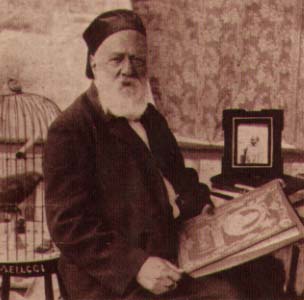 |
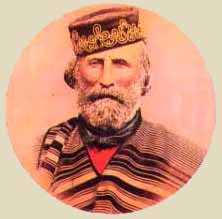 |
Antonio Meucci and Giuseppe Garibaldi in their old age . . .
so different and so alike, always best friends to each other. . .
THE WEEK OF THE ITALIAN CULTURE IN CUBA
Havana, 19-25 November 1999
Note 1.-- All information reported below is taken from the book by Basilio Catania “Antonio Meucci - L'inventore e il suo tempo” (Antonio Meucci - The Inventor and His Times).
Panel F0 - Meucci and Garibaldi
 |
 |
so different and so alike, always best friends to each other. . .
They were about the same age, Meucci being about one year older. Garibaldi, the adventurous, the brave, the audacious and the strategist. . . Meucci, the ingenious, the reflective, the methodical and the scientist. . . Both intelligent, generous, hard workers (and hard smokers), and always ready to fight for Italy as well as for the defense of the poor and the feeble.
Their entire life was permeated by the military and political events connected with the Risorgimento and with the struggles for the unification of Italy, which struggles, to a large extent, identified with the Garibaldian undertakings. Meucci helped with money, when he was in wealthy conditions in Havana, and by recruiting volunteers and sending guns, when he was in New York.
Both adhered to the Freemasonry movement (then, a strong supporter of Italy's unification), reaching the highest Mason ranks.
Panel F1 - Exiles and United
Exile from Florence, Meucci reached Havana in 1835 and New York in 1850. When Garibaldi was also exiled from Italy, he reached New York in 1850, two months after Meucci, who hosted him, together with other Italian exiles, to whom he gave work in his candle factory in Clifton.
Garibaldi too helped in the candle factory, calling Meucci "Principale” (Boss), even many years after he had left America. In his spare time, he often went fishing and hunting. Meucci purchased a small cat boat which was restored by Garibaldi to perfect conditions. They made up a sail bearing the three colors of the Italian flag, and baptized the boat "Ugo Bassi," after the chaplain who was executed by the Austrians during the 1849 campaign. Though Garibaldi was an expert seafaring man, he called Meucci “Capitan Buontempo” (Good-weather Captain), because Meucci used to watch the weather, to see whether it was "good" for sailing and fishing.
Panel F2 - Supporting the Cuban revolution
Garibaldi, in addition to watching events in Italy,
being ready to sail and fight there, was always attentive to
any independence movements, anywhere in the world. Being
acquainted with the political situation of the Cuban
population, mostly through the reports of his friend Meucci,
who had lived in Havana about fifteen years, he most
probably met with Cuban irredentists, such as Narciso
López, Gaspar Betancourt Cisneros (nicknamed El
Lugareño), Cirilo Villaverde and others, at the
Ventura's Restaurant in New York, talking about Cuba's
revolutionary ideas. His answer to an observation about the
Cubans not having any arms, was:
“A brave man can always find a
weapon!” (*). According to a testimony by Adolfo Rossi(**)
and to a tablet (now affixed to the wall near the lateral
entrance on Calle del Obispo of the Museo de la Ciudad de
La Habana), donated by the City of Rome on 2 June 1982
(the centenary of Garibaldi's death), Garibaldi covertly
visited Havana during the Spanish occupation, to gather
information towards organizing an invasion from the USA.
__________
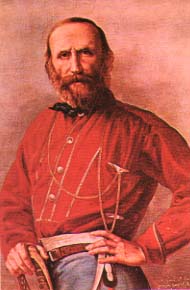
(*)
F. Ortiz: "¿Se
inventó el teléfono en La Habana?", Revista Bimestre
Cubana, vol. XLVII, 1941, 1° bim., pp. 321-335
(**)
A. Rossi: "Un Italiano in
America" (An Italian in America), Casa Editrice La Cisalpina, Milan,
1899
Panel F3 - Garibaldi's death
After Garibaldi died, on 2 June 1882, Meucci practically transformed his cottage in a sanctuary dedicated to his great beloved friend. He placed a marble tablet above the entrance door of his cottage, with an inscription “Here dwelled, exiled, from 1851 to 1854 - Giuseppe Garibaldi, The Hero of the Two Worlds - 8 March 1884 - Placed by a few friends”, and also renamed the entire cottage as "Garibaldi Homestead", placing a large slab high in the attic of his cottage (see photo below).
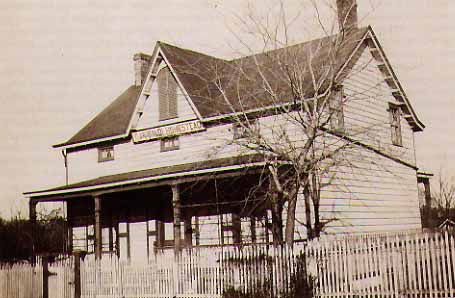
Meucci's cottage, renamed “Garibaldi Homestead”
Floods of Italians went to the "Garibaldi Homestead" every anniversary of Garibaldi's death or of Garibaldian many victories. Humble Meucci escorted the visitors up to the room which was Garibaldi's, lovingly preserved by him with all its original furniture. Some visitors even thought that he was the janitor of the cottage! In his modesty, he preferred to be remembered as Garibaldi's best friend, rather than as the inventor of the telephone. In a photograph of 1887 (see Panel F0), Meucci posed with the many rememberings of his friend: a portrait, a book, a cap similar to Garibaldi's, and the famous parrot, who used to shout “Viva l'Italia! Fuori lo straniero!” (Long live Italy! Out with the foreigners!), which Garibaldi had brought from South America and left with his friend Meucci when he left America for Italy, in January 1854.
Panel F4 - Meucci's death
After Meucci died, in 1889, his cottage became a
sanctuary dedicated to both great Italians, Meucci and
Garibaldi, now honored together, in the place where their
friendship was even more fortified. Flood of Italians as
well as Americans went visiting the cottage on the
anniversaries of both men's birth and death, and this
tradition is still preserved today. On 4 July 1907 the cottage was moved to a nearby location
in Tompkins Avenue, in Rosebank (Staten Island), NY, where
it stands still today. On 16 September 1923, a monument to Antonio Meucci was
inaugurated in the yard in the new location. The monument
(see figure on the left) was sculpted in Italy by Ettore
Ferrari, in marble and bronze. The marble was offered by the
Rome Municipality and the bronze, coming from the Austrian
cannons captured by the Italian Army in Vittorio Veneto, was
offered by the Italian Ministry of War. Meucci's ashes were placed in an urn beneath the
bust.
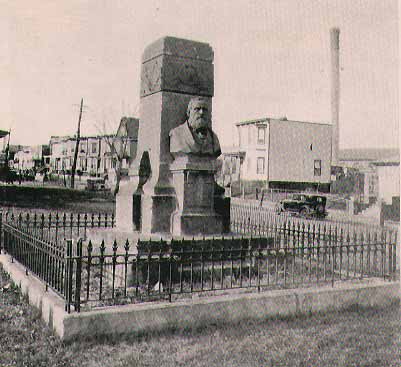
Uninterruptedly, from 1928 on, up until today, the
cottage has been preserved and maintained by the
(Mason) Supreme Lodge Order Sons of
Italy in America. On 12 May 1956, the cottage was
officially renamed “Garibaldi
and Meucci Memorial Museum.” On 13 September 1966, the renamed
Garibaldi-Meucci Museum
(see picture on the right) was declared a
Landmark Site of New York City,
and in April of 1980, it was declared National Monument
of the United States of America and of the State of New
York. (*) The Italian flag always flutters,
together with the flag of the United States of America, in
the yard of the Museum, which was, one time, the dwelling of
the two great Italians. ___________ The “Garibaldi-Meucci
Museum” in Rosebank, Staten Island,
NY
(*)
OSIA News, April 1986.

![]() TO SECTION
3
|||||||||||||||||||||||||||||||||||||
||||||||||||||||||||||||||||||||||||||| TO
SECTION 5
TO SECTION
3
|||||||||||||||||||||||||||||||||||||
||||||||||||||||||||||||||||||||||||||| TO
SECTION 5 ![]()
![]() TO SECTION
2
|||||||||||||||||||||||||||||||||||
TO SECTION
2
|||||||||||||||||||||||||||||||||||
![]() TO
SECTION 1
|||||||||||||||||||||||||||||||||||||
TO
SECTION 1
|||||||||||||||||||||||||||||||||||||
![]()